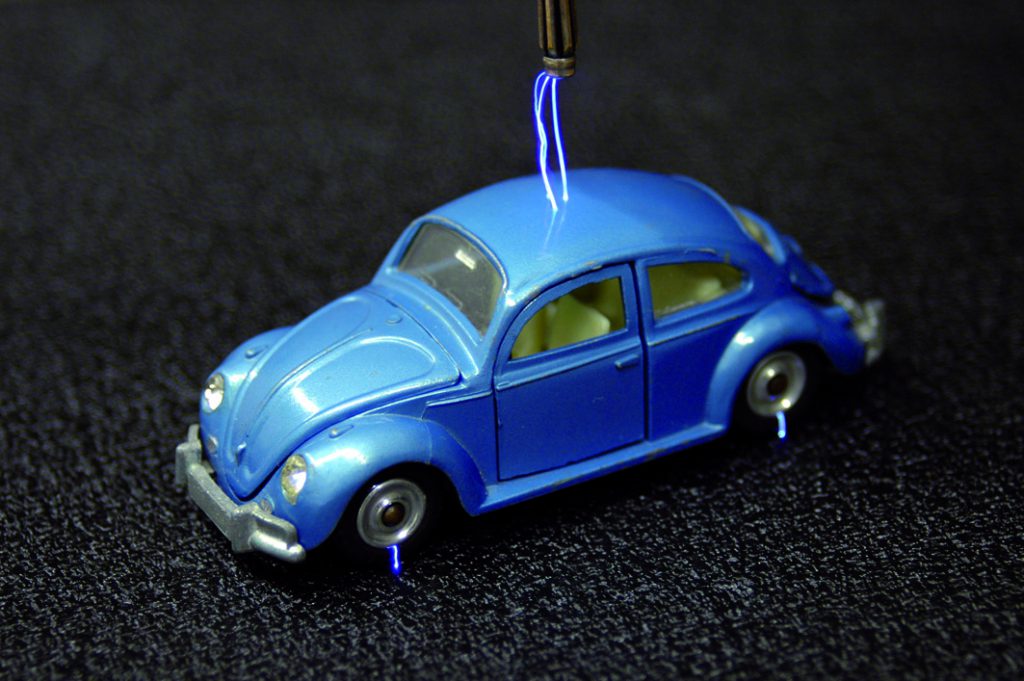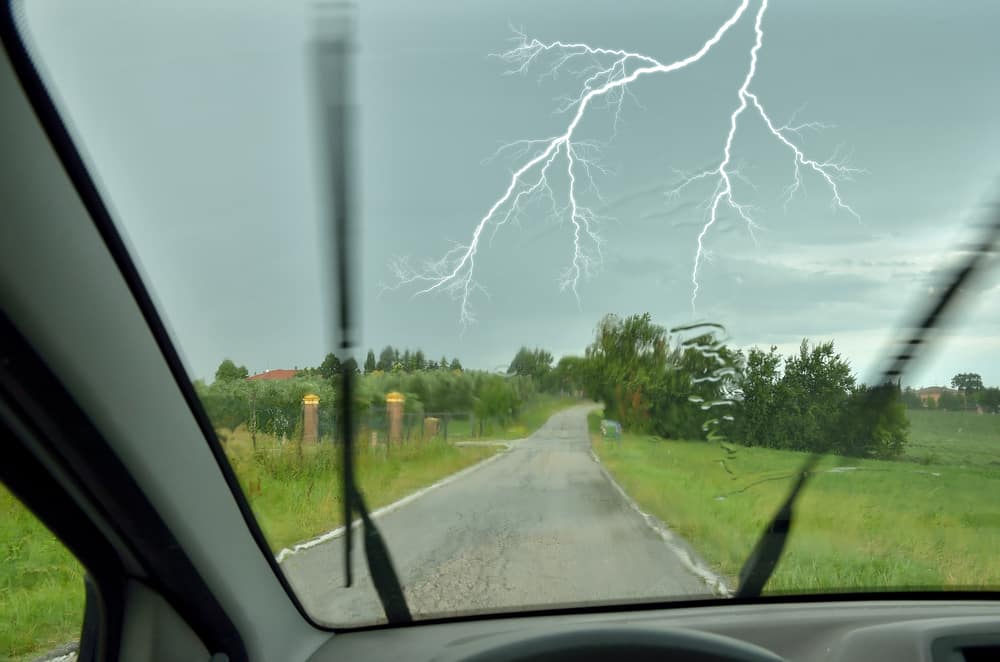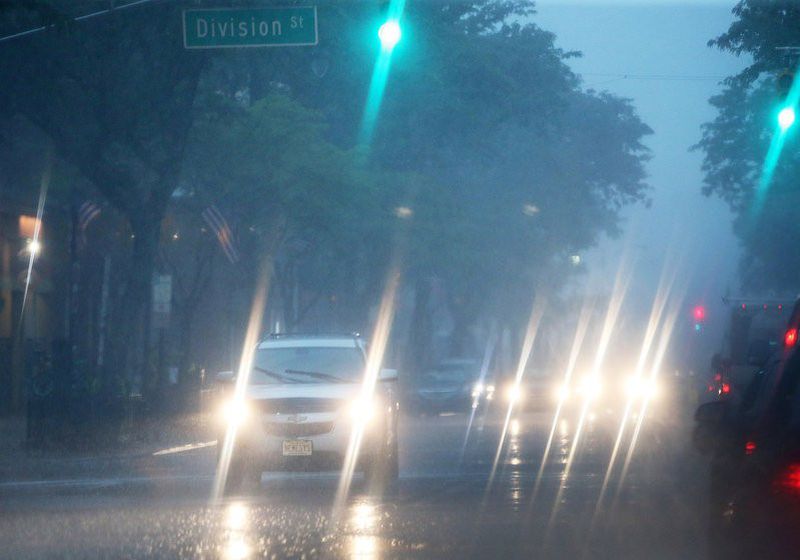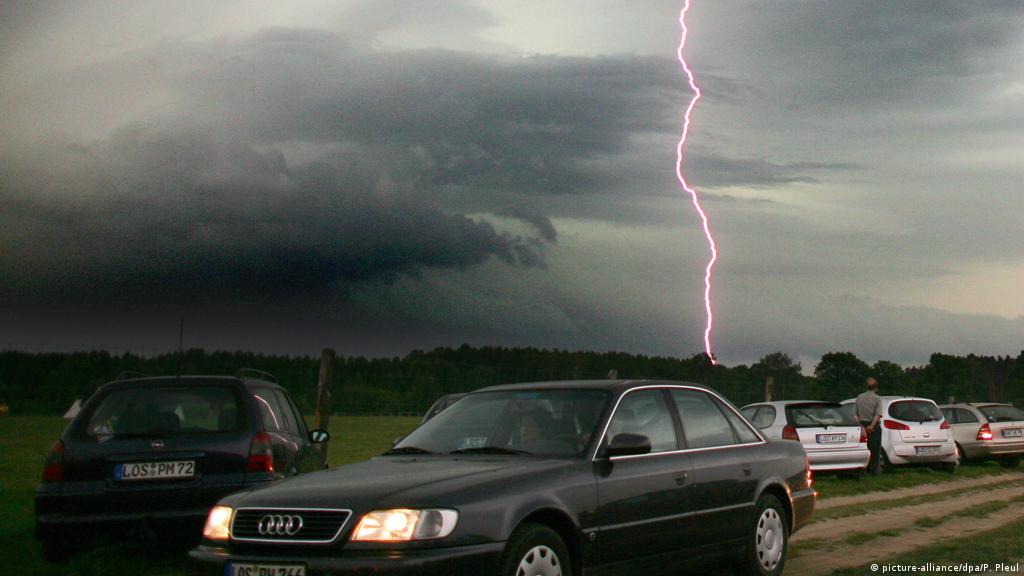How To Tell If Your Car Was Struck By Lightning
Perhaps you are wondering how to tell if your car was struck by lightning as fast as possible since the stormy season has arrived and caused many unexpected concerns for any driver.
The Impacts of Lightning Strikes On Vehicles And Drivers
These concerns derive from several basic causes and common conditions that cars may face during heavy rainstorms. With high levels of wind and rumbling thunder, car drivers can be in danger when not aware and do not know how to prepare, acknowledge and handle any unexpected arising situations related to their safety and those around, especially when the lightning strikes.
According to research, in the US every year, an estimated 15 to 2 million lightning bolts are hitting the ground. The thickness of the lightning is about 5 cm, and the flashing intensity of each flash is equivalent to the power of a 100-watt light bulb covering the usage of 3 months. The lightning speed is 90,000 miles/second (144,000 km/s) with temperature up to 27,760 degrees Celsius. Thunder movement taking place during heavy rain and wind has caused many tragic deaths, just as in 2016 in the US, at least 20 people were struck by lightning and unfortunately could not make it alive.
In terms of the frequency and severity of lightning, as shown above, the data on specific destructive power, and casualties recorded in a report, we can see that this is a unpredictable and dangerous natural phenomenon. And of course, a thing that can be considered tiny in front of wild nature, like a car, will always be in the sights of lightning whenever they have the thousand-of-a-lifetime chance to express themselves in the fury of the sky.
With such powers, lightning hitting cars is not an uncommon problem. Many people are aware of that. But because of their subjectivity or lack of comprehensiveness, they may think that a lightning strike can not affect them or the occupants inside, but only the tires.
However, these thoughts gradually form one of the most harmful misconceptions that still exist among many people when driving in thunderstorms. The car, for them, was an unparalleled haven amid the roaring spectacle of the sky. In theory, people often give lots of logical information to explain this mistaken perception with a solid and reliable physical-scientific basis.
Since then, they have created a wealth of assurance and confidence for a thunderous journey that resounds on an empty route in some driver’s minds, that as long as you sit still in the car when there is a lightning strike, you will be protected in any circumstance.

The cage’s original application is to protect equipment, objects, or people under the effect of electric fields. When an object is inside the Faraday cage, the external electric grid, no matter how powerful it is, will not be able to act on it. In this case, the car body will become a metal cage protecting the interior from sparks or lightning. The occupants of the vehicle hit by lightning will not be affected.
However, according to the US National Lightning Safety Administration (NLS), while cars are generally designed to provide the almost-comprehensive protection in most weather conditions, this is not the case, on both sides. Because for the Faraday effect to work in an ideal environment, it requires a car to be made almost entirely of metal. And we all know that more cars now are built with different materials other than metal.
For vehicles manufactured from non-metallic details such as plastic, fiberglass, or even carbon fiber, which are becoming increasingly common during digital transformation, these materials will hinder the potential for electric current to rush through. And when it does, the “conductor” of electric lightning into the ground will transfer from the car to the person and increase the risk of injury.
No one wants themselves and their beloved car to be in such situation. Every stormy lightning-hit circumstance that happens is just unfortunate as the driver has to reluctantly go out to work or face a big thunderstorm in the middle of a big road.
It doesn’t matter when or where they happen. Whether it heads toward messing up with you or someone else, it’s all good and necessary to be prepared with the knowledge, spirit, and alertness to recognize the signs when your car gets struck by lightning. Because they can come in handy in many situations in the midst of an uncontrollable windstorm or hurricane season.
How To Tell If Your Car Was Struck By Lightning Immediately
If driving a typical passenger car with a soft top, a strong lightning strike can easily affect your entire vehicle, your driving performance, and your safety in general. Sometimes lightning hits will leave visible damage on the car, such as burn marks, stripped paintwork, pitting, and cracking. In other extreme situations, your car windows can crack or break, and the tire or all 4 tires can explode instantly after a flash of light reaches your eyes and thunder sounds. And just as you may fear, the entire vehicle may catch on fire, both exterior and interior, as the lightning strikes the engine or sparks fuel tanks.
So, even if your car is an expensive or shiny new one, serious risks to people and property can always happen in just a few moments. In more detail, when lightning strikes your car, especially when it hits a dangerous place, the car will not work properly anymore. Whether it’s a modern car that runs on electricity, is powered by a diesel engine, or runs on gas, all can’t match the power of a lightning strike.
Moreover, when a car is hit by lightning, some current can flow through and cause aggression to the entire electrical system. At that time, car-mounted metal things such as radios, GPS trackers, mobile phone chargers, vehicle door handles, foot pedals, steering wheels, and steering columns will turn into mini-conductors that appear densely in a confined space. And just the slightest accidental touch can cause you to be jerked or injured without being able to escape in time.
Depending on the point and intensity of the lightning strike, the signs can range from superficial or total damage. The recognizable early signs of damage that can occur in the case of a car struck by lightning can be listed as:
- Burns
- Exploding damaged tires
- Key lost power
- Ignition system problem
- Brake problem
- Airbag deployment
- Broken antenna
- Damage to electrical/electronic systems
- Cracked/broken/cracked windows and windshields
- Lights damage
- Airbag deployment not working
- Engine malfunction
- And worse, the driver and the passengers can be injured

Keep in mind that the electrical energy required for the phenomenon of high-energy bolt strikes is quite remarkable and also rare. However, you absolutely must never be negligent and always be very careful and attentive, especially if you are in an environment with elements that are compatible and elicit lightning. Or when the striking-drawing factors concentrate in one place or are set in the chosen zone during a thunderstorm.
Car Struck By Lightning Insurance
After scrolling through a few notices about what happens if your car gets struck by lightning, you may have to consider repair and check on insurance if your car is unfortunately affected quite a bit. Overall, the damage’s troubleshooting and repair of a vehicle with a severe impact from lightning can drain you out for thousands of dollars. And even replacing a quality detail is enough to put some cash flow burden on your current life plan.
However, you can rest assured that today, most car insurance covers incidents from lightning strikes in premium packages and conditions or policies. These conditions vary depending on the plan drivers want to follow, the location, the ability to pay, and their priority for the vehicle’s protection.
As they say, car insurance is not and never will be a shield that protects your car from being struck by the lightning of all lifetime. But it is a means of backing up and ensuring the safety of your investment and financial ability in a time when bad things may happen to your valuable asset like a car.
If your car is struck by lightning, the type of auto insurance you carry will determine the type of insurance that will cover your car damage. Comprehensive insurance will cover damage from lightning strikes in almost every circumstance, but collision and liability coverage may apply in only a few cases.
Comprehensive insurance
The comprehensive insurance, which covers car damages from any accident that doesn’t affect other vehicles, such as an animal collision or inclement weather damage, will likely cover your car if it is struck by lightning.
For example, let’s say you’re driving, and suddenly a flash of lightning sends a heavy tree branch straight into your car, destroying your windshield. In such a rare event, your comprehensive insurance will most likely cover damage due to the unpredictable nature of lightning and the fact that this weather-related event directly contributed to the total damage. In another example, lightning could hit your car and leave it physically unharmed. But it may have interfered with your vehicle’s electrical system, or your car may not start at all or be able to move. This insurance would technically cover the damage, but the insurer may argue that such insider damage is rooted in something else.
According to the National Association of Insurance Commissioners, comprehensive coverage will cover all collision damage claims, including weather-related damages such as lightning strikes. Even if there is no visible damage to your car, you may need to perform a diagnostic test to identify electrical damage. Your insurance company may decide if the damage could have been caused by anything other than lightning before considering compensation.
Collision insurance
Collision insurance, which covers damage to your vehicle in the event of a collision with another one or a fixed object, is unlikely to cover damage under the effects of a lightning strike. However, a situation may arise where your collision insurance covers lightning-related damage to your vehicle. For example, if a flash of lightning hits your car, causing you to lose control of it and accidentally hit a telephone pole, the insurance, in this case, may likely cover your car if it were partly damaged or total.
Liability insurance
Liability insurance covers damage to another driver’s vehicle and any medical bills that may result from a collision for which you are at fault. It is very unlikely that liability insurance will cover damage to anyone’s vehicle in the event of a lightning strike, but nothing is impossible. For example, if a flash of lightning strikes your vehicle, causing you to lose control and crash, resulting in severe damage or injury to the other driver, you may be liable. In such a case, your liability insurance will cover damage to another driver’s vehicle, not yours, and the injured driver’s medical bills.
>> See More: 8 Reasons Why You Should Have a Car Insurance Policy
Things To Do If Your Car Is Struck By Lightning
Every time discussing this issue, you are always recommended to find a secured building shelter or stay out of your car before the storm with lightning hits to assure optimal safety. That is the case if you find somewhere to head to in the city or crowded streets. However, when being on the empty road, in the middle of nowhere during one severe thunderstorm, the chances that a building or a safe shelter is there waiting for you is close to zero. At this moment, the fear of your car being hit by lightning in your confusing mind can go up to level max. So here are a few things you can do to minimize the dangerous trapped-in situations under the lightning storm.
- Pull over immediately
Imagine bunches of raindrops are knocking harshly against both your front and rear windshield with denser frequency, thunders are rumbling in the distance or right in sight and ear, and bolts of lightning are reaching you closer than ever. Amid the natural chaos, the safest and the only thing you can do to protect yourself effectively is to pull your car over to a safe place, turn off the engine, and wait for the storm to pass or diminish. You must stay out and do not touch the steering wheel or any part of the car connected to the outside in any circumstance.

Under a thunderstorm, these can turn right to bolting magnets. And you may already know the power of a big pole in any form combined with an immense source of natural energy. Driving your car through these markers already makes you a possible striking target, let alone parking the whole metal box nearby.
- Turn on the hazard lights right after pulling over.
In intense thunderstorms, the sky turns dark very quickly. Turning your emergency lights on when pulling over with the engine off will ensure safety and let other drivers see your car’s stopping spot even in limited and blurry vision. Stay inside your vehicle to remain safe, as going out may be considered unwise though there may be chances that lightning will hit.
- Turn the engine off.
Any heavy storm will come to an end. Just be patient sitting in the car with your engine off and full danger lights on.
- Avoid touching metal car parts.
When waiting for a lightning storm to stop in your car, heed that lesson you learned in the first grade, and keep your hands to yourself. If lightning starts raining down, do not touch anything metal, any part of the vehicle connected to the outside of the car, or any components containing metal, such as the dashboard, steering wheel, or gear shift.
Lightning finds a way to get to the ground, so if you are touching a metal component, that component, and by extension, you can become a conductor through which the lightning makes its way to the pavement. You do not want to become a conductor, so keep those hands where you can see them in your lap and do not touch anything until the storm has passed.
Another unfortunate case we need to notice is when you and your family are not lucky enough to dodge that one strike from the sky. If this happens, you can apply the following warnings. Note that these are only warnings and notices in theory, but your calmness and flexibility when it comes are the ones that remain superior.
- First, stay calm.
- Then, call 911 on your phone. Keep your hands away from any metal part or detail and wait for help to arrive. Until the electricity leaves the metal framework and enters the ground, it is not safe to exit your car.
- However, if it is a high-intensity strike and you can smell smoke or burning rubber, you must get out of the car as it is likely that a fire is sparking under the hood.
- If you can open the door using something that is not conducive and avoid touching the sides of the car, that is your best course of action.’Next, find shelter immediately. If none is available, all you should do is crouch down close to the ground and hug your knees. Your main initiative is to take up minimal surface area and be as low as possible.
We hope that this unfortunate circumstance will never happen to anyone and that you can all be secure while coming home healthy and safe. Putting all those dangerous scenarios aside, you have some more things to do if you feel like your car was struck a bit out there. After heading home safely through the storm, you should think about your car insurance policies in case any mechanical issue arises.
If you have comprehensive insurance, you should file an auto insurance claim as soon as your car is unfortunately hit by lightning on a stormy day. Physical damage from lightning is obvious evidence of the occurrence, but electrical problems are more different and challenging to be identified immediately. If you feel your automobile has lightning damage but did not see the hit, you should have a mechanic inspect it to verify any problems. You should also gather meteorological data and reports of the thunderstorm on that day to have proof showing your car’s mechanical troubles were originally caused by a bolt of lightning.
Wrapping Up
Lightning is an extremely unpredictable and dangerous weather phenomenon that can cause an average of over 40 deaths each year in the United States plus hundreds of injuries.

Staying indoors can not only save the life of you and your family but can also save your car from damage. The damage caused by hail is nothing compared to the terrible damage caused by lightning. This huge spark is always a dangerous event, so be sure to always check the weather forecast before setting off on a long journey over deserted roads or mountain passes.
Moreover, for careful drivers who want to be more prepared, consider always keeping a handy talkie with a good connection and adequate electricity or a built-in battery in your car. This high-quality device is not only capable of long-range connection but also sends modern real-time weather alerts. It is also an effective method to contact assistance when your mobile phone is out of range or shut down, which is likely to happen during any extreme lightning event.
To become the calmest and sleekest hard-case breaker, you should know clearly how to tell if your car was struck by lightning, communicate with emergency responders in no time, and get updates on sudden-changing weather patterns. They can all be your lifesaver during a hazard caused by nature. Good luck.














